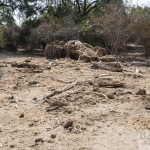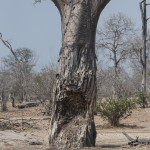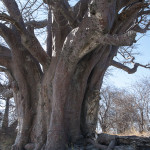A baobab is not only huge but can get very old, too. 1000 years and older are not uncommon. It is one of the most durable plants on our planet. At its death the giant does not fall to the ground heroically. The trees end often resembles wasting away over a stretched period of time into a pile of fibers bleaching in the sun. The clean-up is accomplished by termites – they recycle the remains in a short time. Nothing remains of the former Giant. Of a Baobab that had died in Mana Pools (Zimbabwe) in 2013 roughly a year later nothing was left to see.
- Dead Baobab at Mana Pools
- Dead Baobab at Mana Pools
- Dead Baobab at Mana Pools
Baobabs neither like drought nor flood
The life cycle of a baobab can come to an end in different ways. One is the impact of environmental influences such as floods. If water does not subside immediately after tropical downpours and rather sticks around a baobab the roots might catch root rot. Neither do they survive long periods of drought. Generally the trees are well equipped to withstand droughts because of their ability to store huge amounts of water in their trunks and branches. But extensive periods of lack of water can bring them down, too.
The death of baobabs by drought is a very sad sight. The scarcity of water makes the tree die slowly over several years. First, the top branches die off and fall to the ground. The bark gets wrinkles and crumples. Because it shrinks, a ring of earth forms around the trunk on the ground. A clear indication that the circumference of the tree has decreased.
The fibrous material beneath the bark shrinks faster than the outside bark. The latter peels off. Gradually the larger branches fall off. The trunk exudes a reddish gum that turns white when dry. At this stage the tree gives an unhealthy impression in general at this stage. It collapses in the end or tilts to one side and rots away quickly.
Bushfires and frost – dislike
Due to their high water content severe bushfires can cause the trees to cook to death. Light bushfires, however they survive very well.
Every now and again a story crops up that baobabs spontaneously combust into flames. This is associated with diseased trees that rot from within. The process of rotting inside produces heat. In combination with moisture it may cause the Baobab to ignite itself and burn down slowly. This information is considered controversial. Those opposing it rather assume that a lightning strike could be the cause igniting the tree.
Baobabs dislike frost. They grow only to the frost line in Southern Africa, Namibia and Botswana. Particularly young baobabs are very susceptible to frost. The older specimens can survive light frost for a few days. Heavy frost would kill them, too.
- Baobab with Elephant Damage, Mana Pools
- Baobab with Elephant Damage, Mana Pools
- Baobab with Elephant Damage, Mana Pools
Elephant & Baobab – a fatal affair
Elephants love baobabs. Particularly during times of water scarcity pachyderms are on the lookout for baobab locations. They tear whole pieces from the trunk or branches off the tree to gain water and nutrients.
The trees have a strong capacity for regeneration and are able to withstand attacks by elephants to a certain degree. If the impact of the injury is too big, the tree dies. One can see elephant damage on baobabs in national parks with a particularly high elephant population, for example the Chobe National Park in Botswana or Mana Pools in Zimbabwe.
The greed for land
Humans are by far the greatest threat to baobabs. In times long gone the trees were “sacred” or at least worth protecting in their natural habitats south of the Sahara. But traditions are changing rapidly. Today baobabs have to make room for farmland. The sophisticated cotton production eats more and more arable land. In addition, the Baobab is known to host insects that cause great harm on cotton plantations.
It is not so easy to fell a Baobab. For European trees such as beech or oak trees axes work fine. The same does not apply for baobab – it cannot be cut with an axe easily. The fibers of the baobab are soft and the use of a large steel cable could show more effect than an axe. The principle is similar to a cheese cutter. A strong tractor can pull down a baobab, too but is mostly unavailable in rural and remote areas.
- Baines Baobab with Fireplace
- Baines Baobab with Fungus Spots
- Baines Baobab with Fungus Spots
Do Baobab catch fungus caused by campfires?
Diseases such as fungal attacks can impose huge damage to baobabs. Signs of fungus may be black spots on the bark. Interestingly, some of the Baines Baobabs in Botswana show those spots. A Guide reported that smoke from fire might have triggered the fungus in the trees over a longer period of time. The salt pan around the trees is very suitable for camping. Many travelers passing through set up their campsite beneath the trees and light their campfires too close. Although this is a very romantic idea – for the trees it apparently leads to fungus over time.











